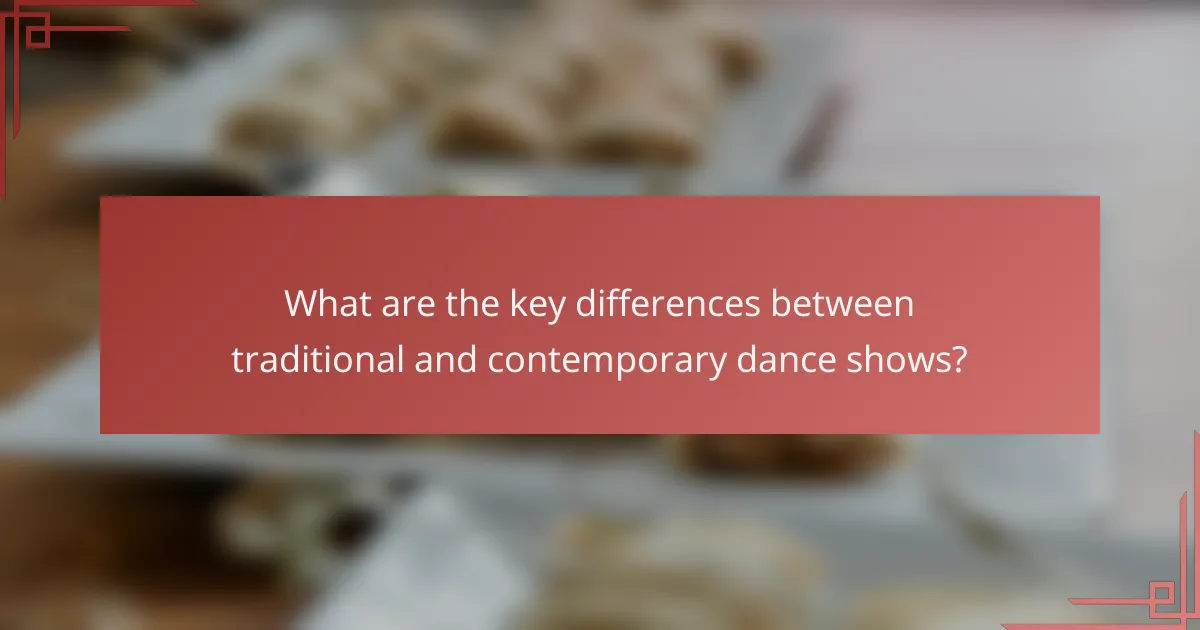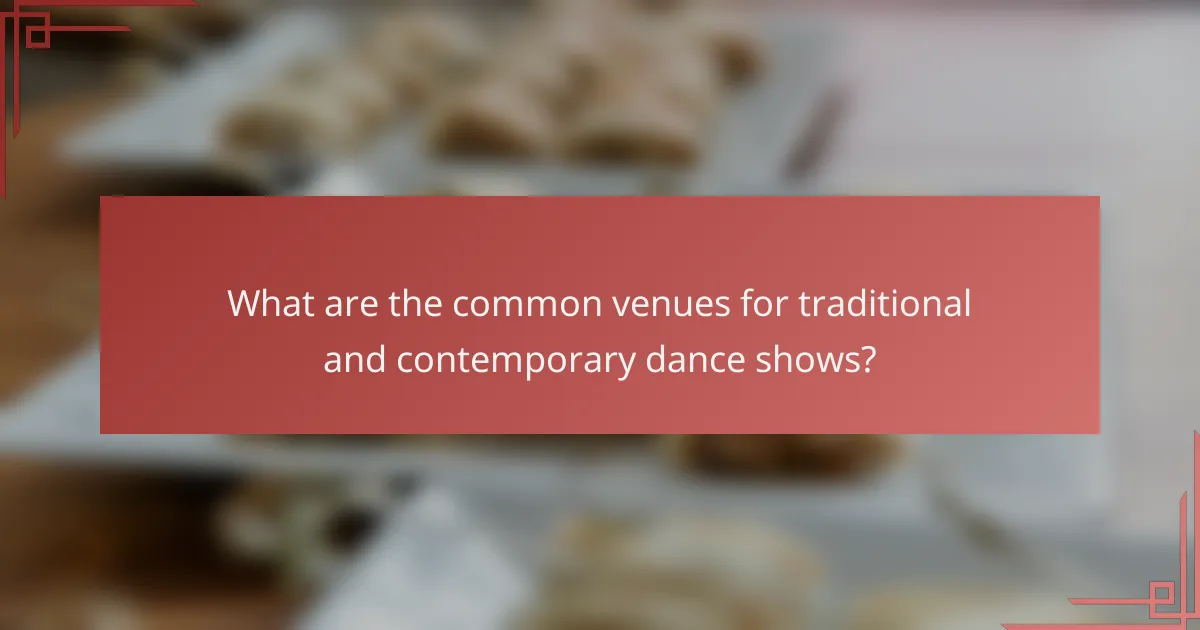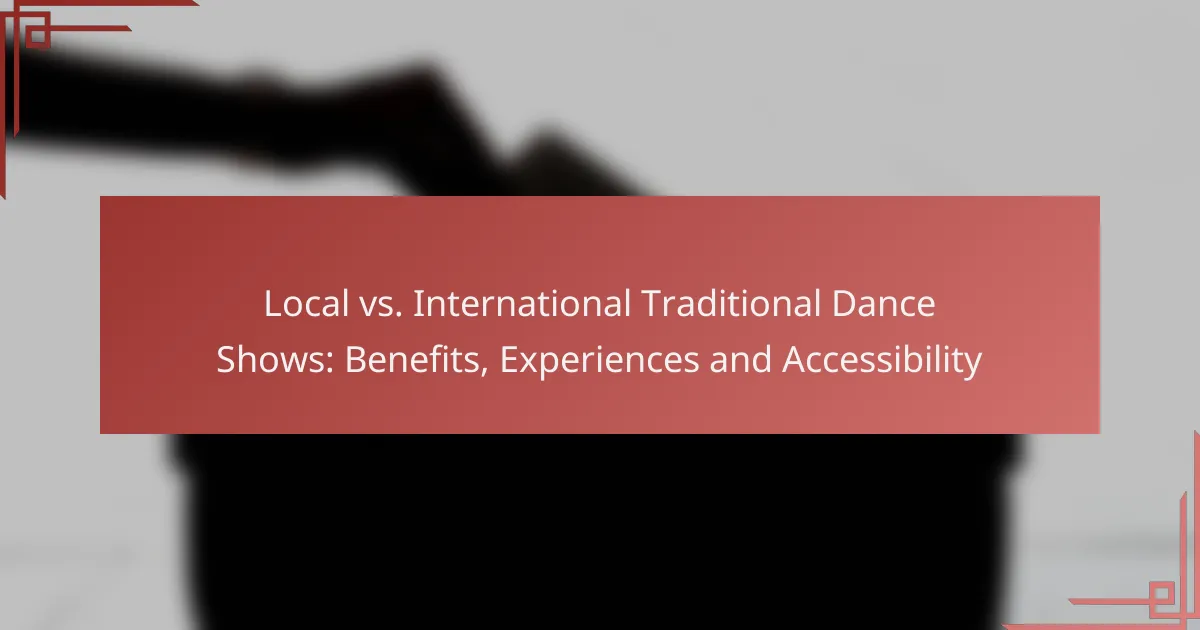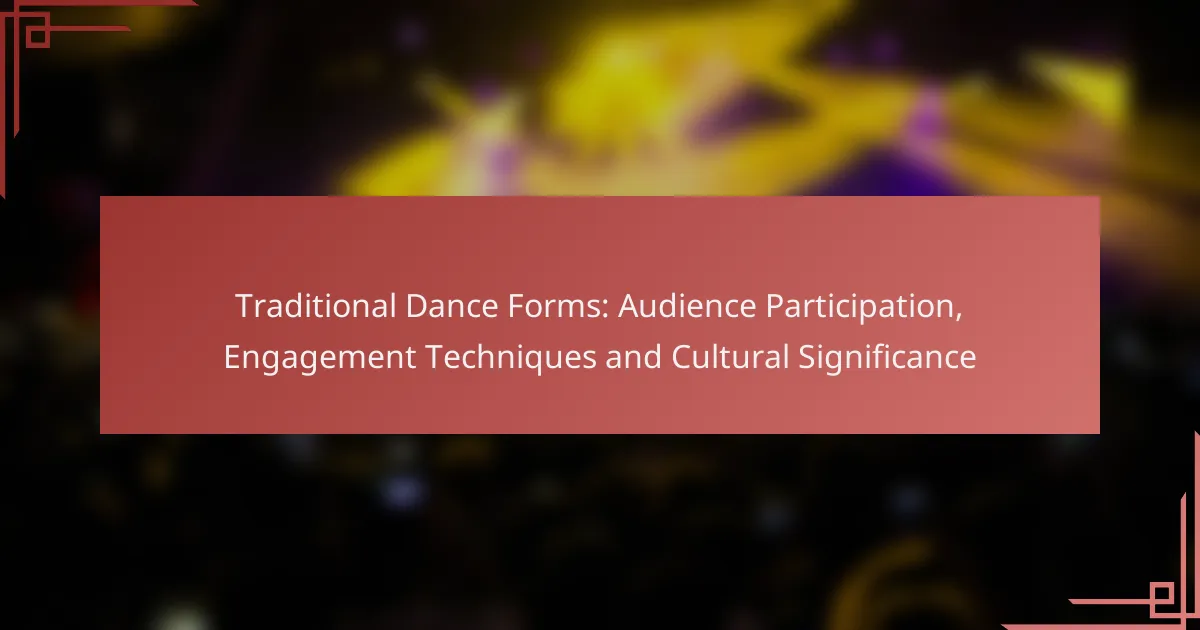Traditional and contemporary dance shows represent two distinct approaches to performance art, each with its own unique characteristics. While traditional dance emphasizes cultural narratives and historical significance, contemporary dance focuses on individual expression and innovation, often addressing modern themes and social issues. These differences are evident in the storytelling, music, costumes, and overall style of the performances.

What are the key differences between traditional and contemporary dance shows?
Traditional dance shows focus on cultural narratives and historical contexts, while contemporary dance emphasizes individual expression and innovation. The differences manifest in storytelling, music, costumes, and overall performance style.
Focus on storytelling in traditional dance
Traditional dance shows often revolve around specific narratives, cultural myths, or historical events. Dancers convey these stories through structured choreography that adheres to established forms and techniques, often reflecting the values and beliefs of a particular culture.
For example, many folk dances tell tales of love, struggle, or community, using movements that are symbolic and rooted in tradition. This storytelling aspect is integral, as it connects the audience to the cultural heritage being represented.
Emphasis on personal expression in contemporary dance
Contemporary dance prioritizes personal expression and individual interpretation over strict storytelling. Dancers often explore themes such as identity, emotion, and social issues, using movement as a medium for self-expression.
This style allows for greater improvisation and experimentation, encouraging performers to incorporate their unique perspectives and experiences into their routines. The result is often a more abstract performance that invites varied interpretations from the audience.
Use of music and rhythm variations
In traditional dance, music typically follows specific cultural rhythms and melodies that complement the choreography. The music is often live, played on traditional instruments, and closely tied to the dance’s historical context.
Conversely, contemporary dance may utilize a diverse range of musical styles, from classical to electronic, often incorporating unconventional sounds and rhythms. This flexibility allows choreographers to create innovative soundscapes that enhance the emotional impact of the performance.
Costume styles and cultural significance
Costumes in traditional dance are usually elaborate and culturally significant, often made from materials that reflect the heritage of the dance form. These outfits are designed to enhance the storytelling aspect and may include specific colors, patterns, and accessories that symbolize cultural identity.
In contemporary dance, costumes can vary widely, from minimalistic to avant-garde designs. The focus is often on functionality and how the costume complements the movement, rather than on cultural representation. This allows for a broader range of creative expression, reflecting the dancer’s individuality and the performance’s themes.

How do traditional dance shows reflect cultural heritage?
Traditional dance shows serve as a vital expression of cultural heritage, showcasing the values, beliefs, and history of a community. They preserve unique dance forms and narratives that have been passed down through generations, connecting audiences to their roots.
Preservation of historical dance forms
Traditional dance shows often focus on preserving historical dance forms that embody the essence of a culture. These performances typically include specific movements, costumes, and music that have historical significance, allowing audiences to experience the art as it was originally intended.
For example, classical ballet in Europe and Kathak in India both represent distinct historical traditions, each with its own techniques and storytelling methods. These forms are not only performed but also taught to new generations, ensuring their survival.
Representation of regional stories and folklore
Traditional dance shows frequently depict regional stories and folklore, bringing local myths and legends to life through movement. This storytelling aspect helps to convey moral lessons, cultural values, and community identity, making the performances relatable and engaging.
In many cultures, dances are performed during festivals or ceremonies to celebrate significant events, such as harvests or weddings. For instance, the Haka from New Zealand tells the stories of ancestors and is performed to honor and unite communities during special occasions.

What are the benefits of attending contemporary dance shows?
Attending contemporary dance shows offers a unique opportunity to experience innovative performances that challenge traditional forms. These shows often highlight current social issues and encourage audience engagement through dynamic choreography and themes.
Exposure to innovative choreography
Contemporary dance shows frequently feature cutting-edge choreography that pushes the boundaries of movement. This style often incorporates elements from various dance forms, including ballet, hip-hop, and even theater, creating a rich tapestry of expression.
Audiences can expect to see a variety of techniques, from improvisational movements to structured sequences that reflect the choreographer’s vision. This exposure can inspire dancers and non-dancers alike, fostering a deeper appreciation for the art form.
Engagement with modern themes and issues
Contemporary dance often addresses pressing social themes such as identity, politics, and technology. By engaging with these topics, the performances resonate with current societal conversations, making them more relatable to audiences.
For instance, a contemporary dance piece might explore themes of climate change or social justice, prompting viewers to reflect on their own experiences and perspectives. This engagement not only entertains but also encourages dialogue and awareness among the audience.

How do audience expectations differ for each dance style?
Audience expectations for traditional and contemporary dance shows vary significantly. Traditional performances often emphasize cultural authenticity and historical context, while contemporary shows focus on innovation and artistic expression.
Desire for authenticity in traditional shows
In traditional dance shows, audiences typically seek a genuine representation of cultural heritage. They expect the choreography, costumes, and music to reflect the historical and social contexts from which the dance originates.
For example, a Bulgarian folk dance performance should include authentic costumes and traditional music, allowing viewers to connect with the cultural roots. Audiences often appreciate when performers maintain the original techniques and storytelling elements that define the dance style.
Appreciation for creativity in contemporary performances
Contemporary dance audiences are generally more open to innovative interpretations and experimental styles. They look for originality and emotional depth, often valuing the choreographer’s unique vision over adherence to traditional forms.
For instance, a contemporary dance piece might blend various styles, incorporate multimedia elements, or explore abstract themes. Viewers appreciate when performers push boundaries and challenge conventional norms, creating a dynamic and thought-provoking experience.

What are the common venues for traditional and contemporary dance shows?
Traditional and contemporary dance shows are typically held in distinct venues that reflect their unique styles and audiences. Traditional performances often take place in formal theaters, while contemporary dance is frequently showcased in more unconventional spaces.
Theater settings for traditional performances
Theater settings for traditional dance performances usually include established venues such as opera houses, concert halls, and dedicated dance theaters. These locations are designed to enhance the viewing experience with features like tiered seating, professional lighting, and acoustics that support live music.
Examples of traditional dance performances include ballet, folk dances, and classical forms, which often require a stage that accommodates elaborate sets and costumes. The formal atmosphere of these theaters adds to the cultural significance of the performance.
Alternative spaces for contemporary dance
Contemporary dance often takes place in alternative spaces such as warehouses, galleries, and outdoor venues. These locations allow for greater creativity in staging and can foster a more intimate connection between the performers and the audience.
Contemporary performances may incorporate multimedia elements and experimental choreography, making them well-suited for flexible environments. This adaptability can attract diverse audiences and encourage innovative artistic expression.

What are the trends in dance shows in major cities?
Major cities are witnessing a dynamic shift in dance shows, characterized by a blend of traditional and contemporary elements. This evolution reflects changing audience preferences and the desire for innovative performances that resonate with diverse cultural backgrounds.
Increased fusion of styles in urban performances
Urban dance performances are increasingly showcasing a fusion of styles, combining elements from ballet, hip-hop, jazz, and even cultural dances. This blending creates a rich tapestry of movement that appeals to a wide audience, making shows more accessible and engaging.
For example, a recent performance in New York City featured dancers seamlessly transitioning between classical ballet and street dance, illustrating how different genres can coexist and enhance storytelling. This trend encourages choreographers to experiment, pushing the boundaries of traditional dance forms.
Growing popularity of immersive dance experiences
Immersive dance experiences are gaining traction, inviting audiences to engage with performances in a more interactive manner. These shows often break the fourth wall, allowing viewers to move through the performance space and experience the action up close.
In cities like London and Berlin, immersive dance productions are becoming a staple, often set in unconventional venues such as warehouses or outdoor spaces. This format not only enhances the emotional impact of the performance but also fosters a deeper connection between the dancers and the audience.

How can one choose between attending a traditional or contemporary dance show?
Choosing between a traditional or contemporary dance show depends on your personal preferences, cultural interests, and the type of experience you seek. Traditional performances often reflect historical and cultural narratives, while contemporary shows may explore modern themes and innovative choreography.
Consider personal taste and cultural interests
Your personal taste plays a significant role in deciding between traditional and contemporary dance. If you appreciate cultural heritage, traditional dance showcases like ballet, folk, or classical forms may resonate more with you. Conversely, if you enjoy experimentation and modern expressions, contemporary dance could be more appealing.
Consider attending a variety of performances to better understand what captivates you. Many cities offer festivals or showcases that feature both styles, allowing you to compare and contrast them directly.
Evaluate the themes and messages of the performances
The themes and messages conveyed in dance shows can greatly influence your choice. Traditional performances often focus on storytelling, cultural rituals, or historical events, providing a rich context that connects audiences to their heritage. In contrast, contemporary dance frequently addresses current social issues, personal experiences, or abstract concepts, often leaving interpretation open to the viewer.
Before attending, research the specific performances to understand their themes. Look for reviews or program notes that outline the intent behind the choreography, as this can help you align your interests with the show’s focus.

What are the emerging trends in dance shows?
Emerging trends in dance shows reflect a blend of traditional techniques and contemporary influences, showcasing diverse styles and innovative choreography. These trends often emphasize inclusivity, technology integration, and cross-genre collaborations, appealing to a broader audience.
Integration of Technology
Technology plays a significant role in modern dance shows, enhancing visual storytelling and audience engagement. Dancers now frequently use digital projections, interactive lighting, and even augmented reality to create immersive experiences. This integration allows choreographers to push creative boundaries and offer unique interpretations of traditional forms.
Focus on Diversity and Inclusion
Diversity and inclusion are increasingly prioritized in dance shows, with a growing emphasis on representing various cultures and backgrounds. This trend encourages the exploration of different dance styles, fostering a richer artistic dialogue. Companies are actively seeking to include performers from underrepresented communities, enriching the overall narrative of their productions.
Cross-Genre Collaborations
Cross-genre collaborations are becoming more common, merging dance with other art forms such as theater, music, and visual arts. These partnerships create dynamic performances that attract diverse audiences and challenge conventional boundaries. For example, a dance show might incorporate live music or spoken word, enhancing the emotional impact and storytelling.
Emphasis on Social Issues
Many contemporary dance shows address pressing social issues, using movement as a medium for commentary and reflection. Themes such as climate change, mental health, and social justice are explored through choreography, inviting audiences to engage with important topics. This approach not only entertains but also educates and inspires action.



